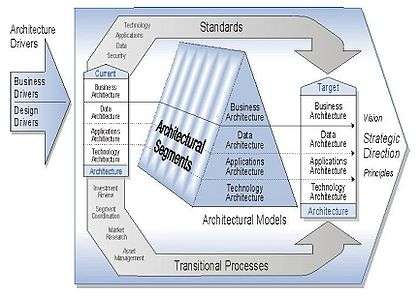Architecture domain

An architecture domain in enterprise architecture is a broad view of an enterprise or system. It is a partial representation of a whole system that addresses several concerns of several stakeholders. It is a description that hides other views or facets of the system described.
Overview
Since Stephen Spewak's book called enterprise architecture planning (EAP) in 1993, and perhaps before then, it has been normal to recognise four types of architecture domain:
- Business architecture
- Data architecture
- Applications architecture
- Technology architecture
Note that the applications architecture is about the application portfolio, not the internal architecture of a single application - which is often called the application architecture.
Many EA frameworks combine data and application domains into a single layer, sitting below the business (usually a human activity system) and above the technology (the platform IT infrastructure). There are many variations on this theme.
Typical architecture domains
Typical architecture domains are listed below, and defined drawing on the definitions found in The British Computer Society's "Reference Model for Enterprise and Solution Architecture".
- Business architecture: The structure and behaviour of a business system (not necessarily related to computers). Covers business goals, business functions or capabilities, business processes and roles etc. Business functions and business processes are often mapped to the applications and data they need.
- Data architecture: The data structures used by a business and/or its applications. Descriptions of data in storage and data in motion. Descriptions of data stores, data groups and data items. Mappings of those data artifacts to data qualities, applications, locations etc.
- Applications architecture: The structure and behaviour of applications used in a business, focused on how they interact with each other and with users. Focused on the data consumed and produced by applications rather than their internal structure. In application portfolio management, the applications are usually mapped to business functions and to application platform technologies.
- Application (or Component) architecture: The internal structure, the modularisation of software, within an application. This is software architecture at the lowest level of granularity. It is usually below the level of modularisation that solution architects define. However, there is no rigid dividing line.
- Technical architecture or infrastructure architecture: The structure and behaviour of the technology infrastructure. Covers the client and server nodes of the hardware configuration, the infrastructure applications that run on them, the infrastructure services they offer to applications, the protocols and networks that connect applications and nodes.
See also
- Enterprise Architecture framework
- Federal Enterprise Architecture
- Solution architecture
- TOGAF
- Architecture Patterns (EA Reference Architecture)
References
- ↑ Chief Information Officer Council (2001) A Practical Guide to Federal Enterprise Architecture. Feb 2001.